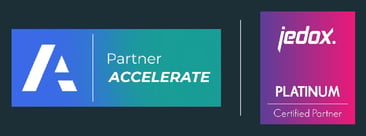Implementing new software within a business is a crucial way of improving performance and outperforming the competition. Key changes to industries and markets mean that the way organisations work is becoming more dependent on digital technologies to meet customer expectations..
So why should a business invest in software implementation and what are the challenges that arise?
IMPROVING BUSINESS WITH THE LATEST SOFTWARE
The popularity of cloud-based software can determine the impact of new, developing technology on businesses today. When surveyed, over 40% of businesses reported better resilience as their top reason for employing these types of software with just under 40% citing improved agility as the main reason.
With improvements in the fields of business-related technology, such as SEO and digital marketing, Connected Planning and social awareness, even smaller businesses can capitalise on these developments. This creates a very dynamic market for any industry, so it's clear that businesses need to use the latest technology to keep up with the trends.
WHY TECHNOLOGY IS WORTH THE OVERHEADS
In the UK, average labour costs per hour vary per industry, but those that stand to gain the most from new technology are the ones with the highest costs. On average, financial and insurance services are paying up to £50 an hour for wage and non-wage costs combined per employee.
The average price of business technology? Around £2300 per year, which equals £1.80 per working hour (based on an average of 42 weeks of 35 working hours per week). Evidently, this is a massive difference in cost. Plus, the demand for business-related software for both large and small businesses has led to an incredibly competitive market.
Flint Brenton, the CEO and President of CollabNet, writes: “This current wave of digital transformation is driven by a great need for fast, safe and reliable software solutions because the customer experience now lives on apps and sites, and software is what makes them functional, beautiful and successful.”
Last year, Gartner projected that software spending would grow by 8.2%, totalling a vast $466 billion in 2020. This means it’s a highly attractive industry for current and future developers.
Due to the market size and variety, technology doesn’t have to be expensive. There’s a vast range of competitively-priced options on the market today. Whereas salaries and office upkeep can come in as a fair amount of money per hour, the cost of running a new technology is much smaller in price tag.
IMPROVING INTERACTIONS WITH CUSTOMERS
Video, chatbots, integrated business planning, artificial intelligence, cloud-based accessibility, natural language processing and real-time messaging. These are all fantastic examples of how technology can improve interactions and relations between a business and a customer.
As our systems become more and more integrated, we’re met with a huge influx of valuable customer and industry data. One of the most important ways tech will influence customer service in the future is the interactions we have are becoming increasingly data-driven.
Service technologies such as CRMs or Connected Planning software can record, segment and analyse a variety of both internal and external data, identifying key areas for improvement and points that require increased collaboration. The most obvious example of Amazon, who put data at the centre of their business strategy and have been extremely successful at creating an exceptional customer experience.
The American food production company Del Monte suffered from disjointed inventory management caused by siloed data and inflexible legacy tools. They used Anaplan’s Connected Planning platform to shorten their supply chain from two weeks to two days - improving their overall efficiency and delighting customers.
THE CHALLENGES OF IMPLEMENTING TECH
There are several challenges when it comes to implementing technology, especially for the uninitiated. At Profit&, we specialise in implementing planning technology. From our experiences across multiple implementations over many business use cases, we’ve found that these following challenges are the most common.
1. Measuring ROI
The first challenge you may face when implementing new technology is measuring the ROI of your tech. The need for this new software comes through a specific business case - a problem, issue or inefficiency that needs solving. ROI itself is something that can convince every CEO, Director or Manager that the new technology or software is doing its job.
It may seem like the actual ROI can be hard to pin down - but it’s not impossible. For example, Forrester released a report on the Total Economic Impact of Anaplan, calculating that it can deliver a 324% ROI over three years. This isn’t surprising - given that the software enables Connected Planning, driving collaboration and faster, deeper insights from data.
2. Getting new business processes right
With new technology or software, there's a chance it affects your current business processes which means you might need to alter the way you work to get the most from it. It can sometimes be the case that businesses don’t adapt to changes in the internal environment so instead of helping, the new tech or software begins to hinder.
For instance, implementing Anaplan causes key changes to planning processes as it enables lateral thinking and planning capabilities that weren’t available before. The way around this is to redefine these processes at the outset, rather than trying to replicate the old system in an attempt to fit the two things together. In doing so, you will achieve greater business value from your implementation, as replication tends to limit this.
3. Democratise planning and technology use
Within the competitive marketplace, it’s increasingly important to plan proactively and make sure the planning process is both accessible and democratised.
Connected Planning software puts planning into the hands of more people which enables a more detailed and granular level of data collection and manipulation.
While this does mean a business turns away from slow and inaccurate manual data processes, it also suggests they need to teach their workforce how to use the technology in order to increase engagement and company-wide buy-in. This can be an issue if you don’t know how to do it.
Fortunately, with Connected Planning software in particular, it’s not just the software that comes in the package - but also the partner experience as well. Due to the wide marketplace for tech and software, choosing a bespoke and personalised professional support network is key to proper implementation.
4. Manage change
New tech and software cause changes, especially within planning processes. Access to larger amounts of near-real-time data and complex algorithms means past relationships between departments and decision-making processes can get shaken up.
Even an increase in collaboration can have the adverse effect of slowing down everyday functions if individuals aren’t on the same page. The quick fix is to work with a service provider to teach your workforce the significance, features and functions of the new tech and software.
The implementation process needs to be properly managed across both sides of the software. For example, this quote from the Senior Finance Director of Consumer Packaged Goods shows how much new software can help to manage those changes:
“Anaplan is really an enabler as we added significant process changes… I think Anaplan’s flexibility has allowed us to really build and change the processes quicker than with other systems… I think with Anaplan, its usability and its speed to build allows you to embed those changes quicker.”
New technology comes in many shapes and forms, but one of the most impressive for transforming businesses is Connected Planning software. Think of it as the next stage of digital transformation, after ERP, helping to unify planning processes across business functions. Software such as Anaplan improves collaboration, transparency, customer satisfaction and reaction times across the board - but what does it look like in action?
Explore Profit&’s Anaplan Case Studies
Profit& have worked with many high-profile clients over the years and through the implementation of integrated Connected Planning software, we’ve increased collaboration and collaborative S&OP across the board.
Click the button below to see how we implemented this new software and its benefits.





